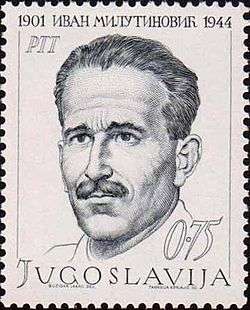Ivan Milutinović
Ivan Milutinović (nickname Milutin; Serbian Cyrillic: Иван Милутиновић; 27 September 1901 – 23 October 1944) was a Yugoslav Partisan general and an eminent military commander who participated in World War II in Yugoslavia.
Ivan Milutinović | |
|---|---|
.jpg) Ivan Milutinović on April 1, 1942 | |
| Native name | Иван Милутиновић |
| Nickname(s) | Milutin |
| Born | 27 September 1901 Podgorica, Principality of Montenegro |
| Died | 23 October 1944 (aged 43) Belgrade, DF Yugoslavia |
| Allegiance | |
| Years of service | 1941–1944 |
| Battles/wars | |
| Awards | |
Before the war
In October 1940, during the Fifth Land Conference of the Communist Party of Yugoslavia held in Zagreb, Milutinović was elected as a member of Politburo.[1] At this conference Tito formulated the leftist strategy of the CPY as focused on a revolutionary seizure of power in the country in order to organize a Soviet-style administrative organization in Yugoslavia.[2][3][4] Besides Milovan Đilas and Boris Kidrič, Milutinović would become one of the major proponents of the policy of leftist errors pursued during the Second World War.[5]
Second World War
On 27 June 1941 Milutinović was elected as a member of the Supreme Staff of the National Liberation Partisan Units of Yugoslavia.[6] During the Uprising in Montenegro, Chetnik commander Bajo Stanišić wanted to negotiate with the Partisans but Ivan Milutinović, as a commander of the Partisan forces in Montenegro, refused to reply to Stanišić's proposal.[7] Milutinović had numerous exhausting polemics with Terence Atherton in futile attempts to convince him to change his positive view about Chetnik leader Draža Mihailović.[8]
Death
Ivan Milutinović died on 23 October 1944 when a small boat which was transporting him to Belgrade hit a naval mine in the Danube. He was decorated with the Order of the People's Hero.[9]
The remains of Ivan Milutinović were buried in the Tomb of People's Heroes in Belgrade.
Legacy

From 1949 until 1992 Berane was named as Ivangrad (Serbian: Иванград) in honour of Milutinović. Until 2006 the Square of the Republic in Podgorica was known as Ivan Milutinović Square. The leading company for waterways in former Yugoslavia and today in Serbia is PIM Ivan Milutinović.[10] Many schools in former Yugoslavia carried Milutinović's name. Some schools in Serbia and Montenegro still do.
References
- Rusinow, Dennison (1978). The Yugoslav Experiment 1948–1974. University of California Press. p. 8. ISBN 978-0-520-03730-4.
... and Ivan Milutinovic, a Montenegrin) comprised the new Politburo presented to a secret all-Yugoslav Party Conference...
- Joel Krieger (2 August 2001). The Oxford Companion to Politics of the World. Oxford University Press. p. 838. ISBN 978-0-19-511739-4.
...in 1939 and received internal confirmation at the Fifth Land Conference of the KP], held in Zagreb, in October 1940. Tito was already noted as a leftist who put little stock in Popular Front arrangements with non-Communists. Moreover, he was federalist, seeing the solution of the nationality question in Yugoslavia in Soviet style federation. This led him to complain against Soviet pleas for cooperation with anti-Communist and Greater Serbian Chetniks during the war and prompted him to emphasize the revolutionary seizure of power.
- Encyclopædia Britannica, inc (1998). The New Encyclopædia Britannica. Encyclopædia Britannica. p. 804. ISBN 978-0-85229-633-2.
At Fifth Land Conference of CPY, as underground minicongres held in Zagreb in October 1940, Tito sketched CPY's leftist strategy, which focused the party on armed insurrection and on Soviet style federalist solution to Yugoslavia.
- Banac 1988, p. 77.
- Banac 1988, pp. 82, 83.
- Ramet 2006, p. 142.
- Marković, Lazo (1970). Ivan Milutinović Milutin. Grafički zavod. p. 235.
- (Marković 1970, p. 167): "За вријеме док су у Главном штабу за Црну Гору и Боку боравили енглески мајор Теренс Атертон, један бивши југословенски официр и телеграфиста Ирац Пат, Иван је водио са енглеским официром исцрпљујуће полемике."
- Vojnoistorijski institut (Belgrade, Serbia) (1959). Zbornik dokumenata i podataka o narodnooslobodilačkom ratu jugoslovenskih naroda. p. 348.
Ivan Milutinovic, narodni heroj. Poginuo 23 oktobra 1944 god. na putu za tek oslobodeni Beograd (brodic kojim se prebacivao preko Dunava naisao je na minu).
- "PIM Ivan Milutinović". PIM Ivan Milutinović website. Retrieved 2 April 2014.
IVAN MILUTINOVIC-PIM, Serbian leading engineering and contracting company for waterways.
Sources
- Banac, Ivo (1988). With Stalin Against Tito: Cominformist Splits in Yugoslav Communism. Cornell University Press. ISBN 0-8014-2186-1.CS1 maint: ref=harv (link)
- Marković, Lazo (1970). Ivan Milutinović Milutin (in Serbian). Grafički zavod.
- Ramet, Sabrina P. (2006). The Three Yugoslavias: State-Building and Legitimation, 1918–2005. Bloomington, Indiana: Indiana University Press. ISBN 978-0-253-34656-8.CS1 maint: ref=harv (link)
External links
| Wikimedia Commons has media related to Ivan Milutinović. |